6 Good Dental Advertising Examples and ROI (Return On Investment)
There are dozens on ways you can advertise for your dental practice, including online advertising and traditional offline advertising and print advertising. However, these days there are certain strategies that perform better than others. Dental advertising is more than putting a sign-out front saying, “accepting new patients”.
As the owner of a dental practice, you need to advertise your business to maintain and build your patient count. Dental advertisement is more than putting a sign-out front saying, “We are accepting new patients, call us” While this may have worked in the past, a bit more effort must be made by the dental practice owner in the highly competitive world of healthcare to achieve the results they want. Below are specific examples used by top dental practices. Also there is a difference between dental advertising and dental marketing.
Table of Contents:
1) Example 1 for dental advertising – Example of an intelligent mobile focused, high conversion website
2) Example 2 for dental advertising – SEO of the website. Patient is look for a root canal specialist in DC area
3) Example 3 for dental advertising – Google PPC advertising: A potential patient is searching for dental implants in Dallas TX
4) Example 4 for dental advertising – Instagram advertising: A potential patient is presented with a display ad based on interests, demographics and geo data from Instagram advertising engine
5) Example 5 for dental advertising – Facebook advertising: A potential patient is presented with a display ad based on interests, demographics and geo data from the Facebook advertising engine
6) Example 6 for dental advertising – Facebook posting app: Facebook posting app provides an effective way for your dental patients to engage with your practice and receive offers and up to date information about oral health.
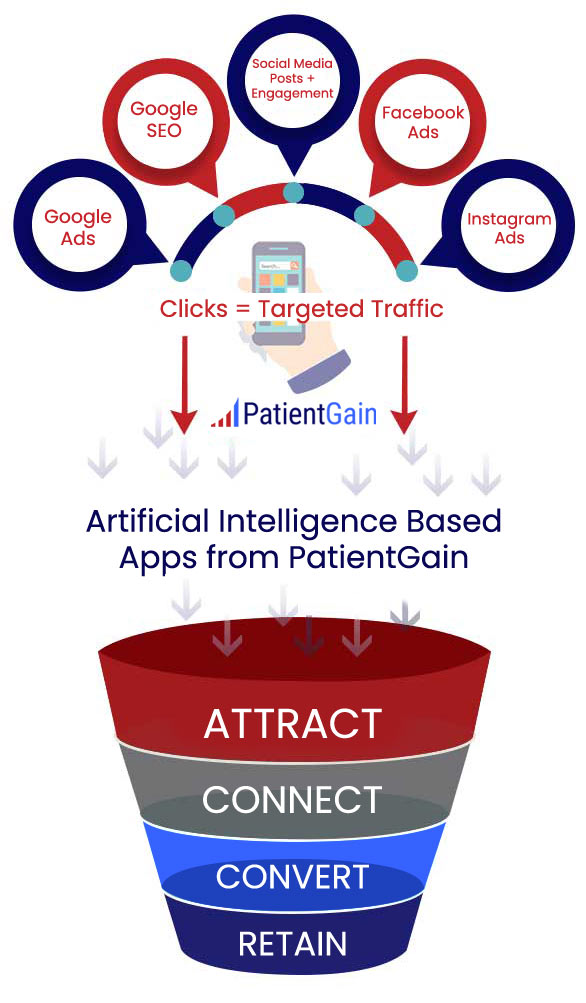
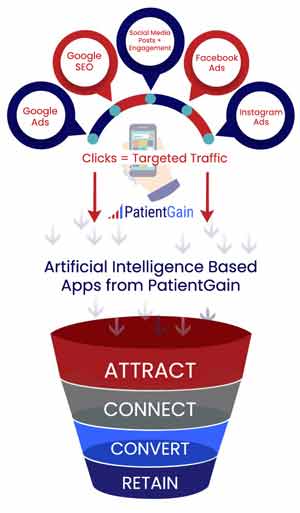
Example 1 for dental advertising – Example of an intelligent mobile focused, high conversion website
Start with a conversion focused mobile optimized website. If you do not have a good website designed for conversions, advertising will be sub-optimal. Your website is the first face of your dental business, it is also the first thing a patient sees. It should be intelligent, with apps, and designed for mobile users. 82 percentage of your patients visiting your website are on mobile devices like Android and iPhones.
Example of an intelligent mobile focused, high conversion website. 1) Website loads extremely fast on mobile devices 2) Has intelligent Chat*Bot that helps your dental practice convert potential patients to new paying patients 3) Patients can send a secure text to your dental practice while they are on your website. 4) Patients can call you and software can track new patient calls 5) There are offers and call to action for high profit margin services. 6) There is HIPAA compliant CRM – patient marketing database connect to the website. 7) There are additional 11 apps working behind the scenes to help improve your dental marketing.
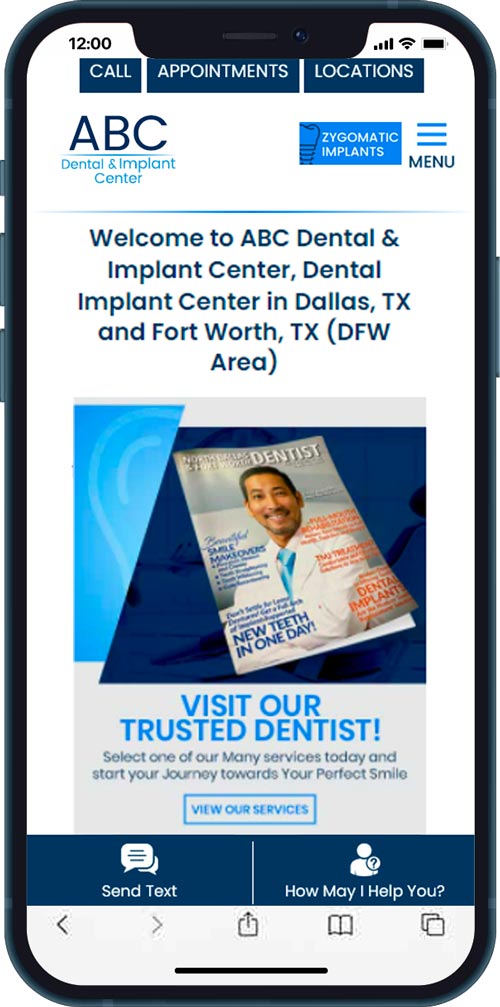
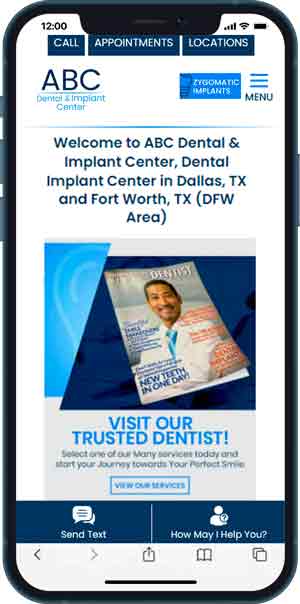
Example 2 for dental advertising – SEO of the website. Patient is looking for a root canal specialist in DC area
Once your website is created, you will have make it visible to search engines and tell every possible potential dental patient, that you exist and you offer great dental services in your area and city. This process of informing search engines about your dental practice and your services is called dental Search Engine Optimization, also known as dental SEO. There are hundreds of search engines. The most important one is Google search engine. 95 percentage of people in US and Canada use Google search. We recommend optimizing your dental website for Google search engine first. Our data shows that 78 percentage of your online success is tied to Google, so make it your focus.
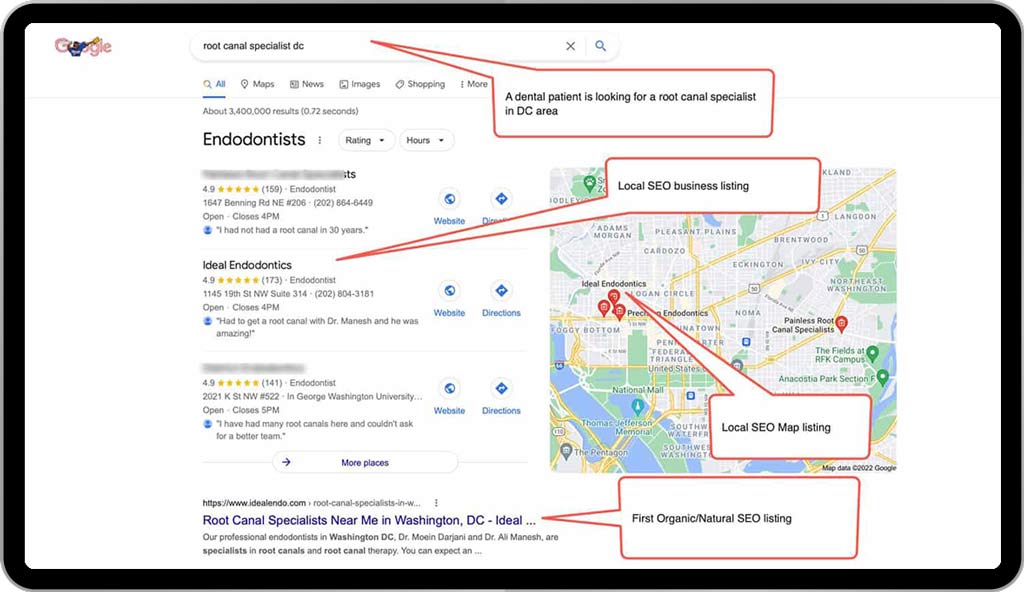
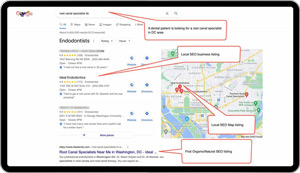
Example 3 for dental advertising – Google PPC advertising: A potential patient is searching for dental implants in Dallas TX
Adverting on Google for your medical practice can be very effective. PatientGain has hundreds of examples with excellent ROI.
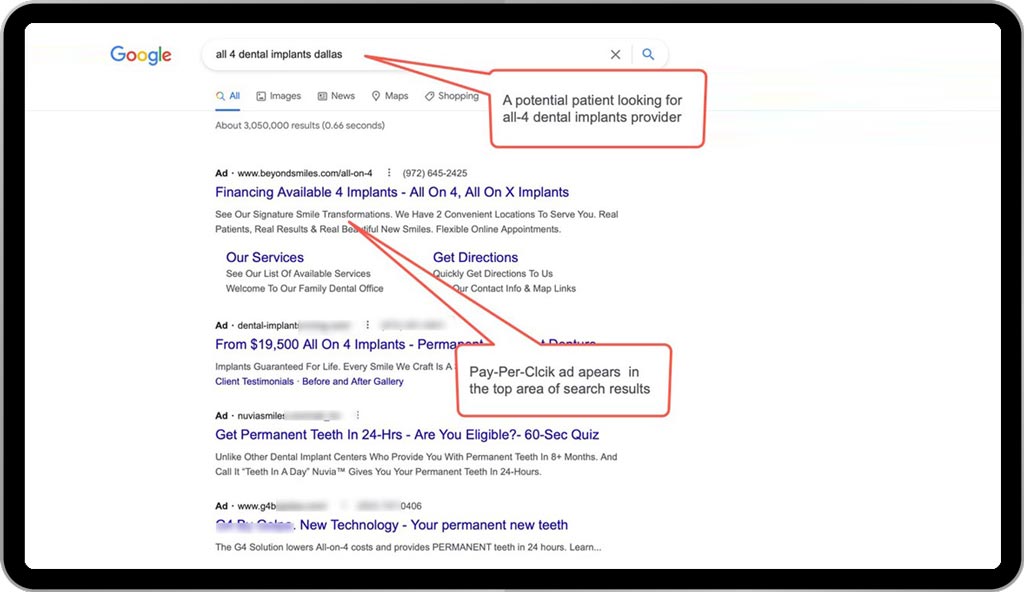
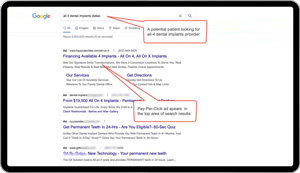
Example 4 for dental advertising – Instagram advertising: A potential patient is presented with a display ad based on interests, demographics and geo data from Instagram advertising engine
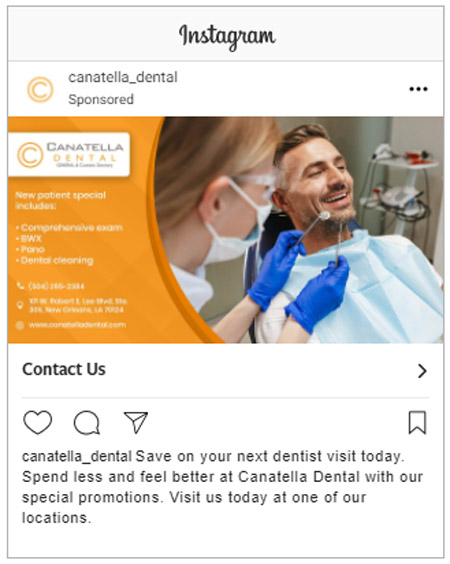
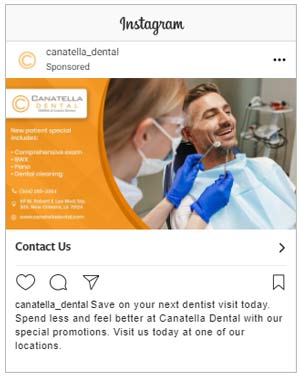
Example 5 for dental advertising – Facebook advertising: A potential patient is presented with a display ad based on interests, demographics targeting using Facebook advertising engine
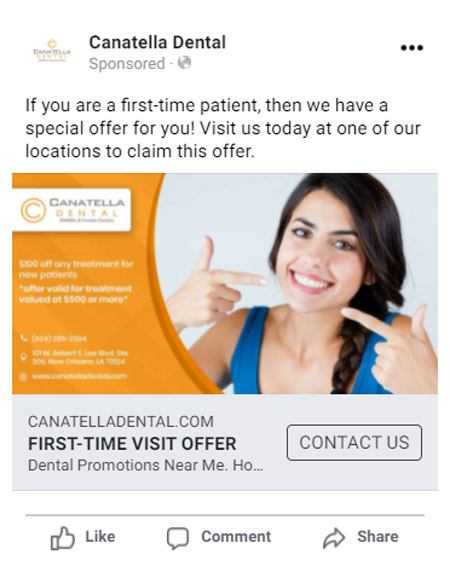
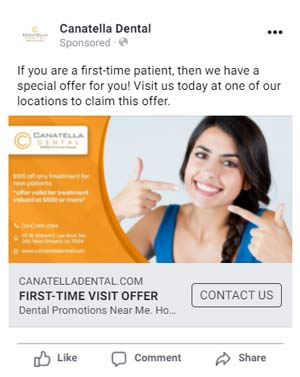
Example 6 for dental advertising – Facebook posting app: Facebook posting app provides an effective way for your dental patients to engage with your practice and receive offers and up to date information about oral health.
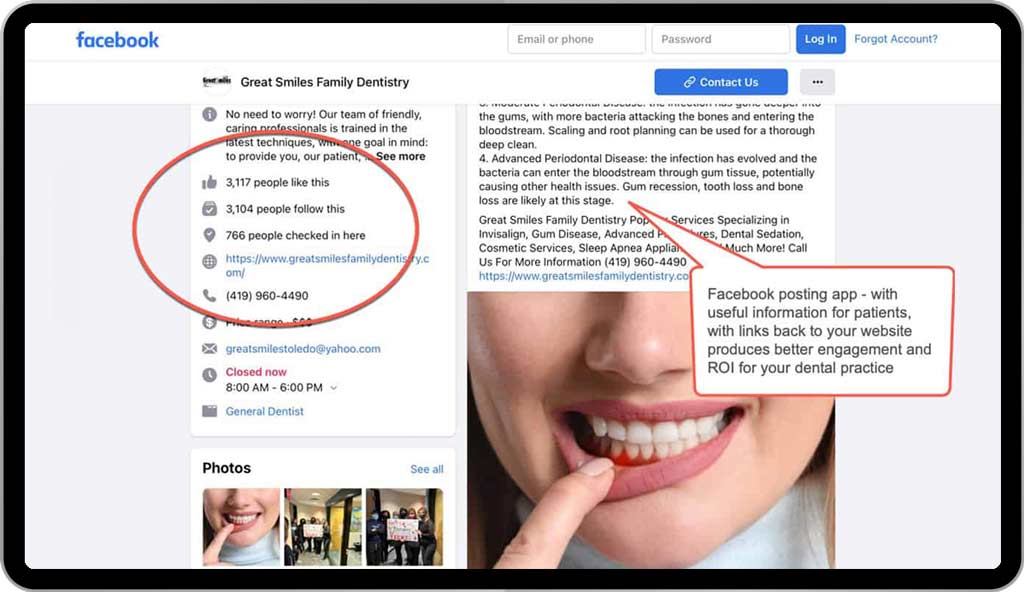
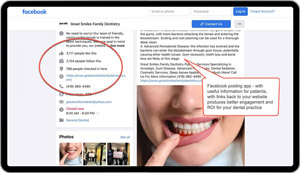
Example of a dental practice marketing dash board. Tracking of leads and conversion is included in the leads funnel app, included the monthly GOLD or PLATINUM service.
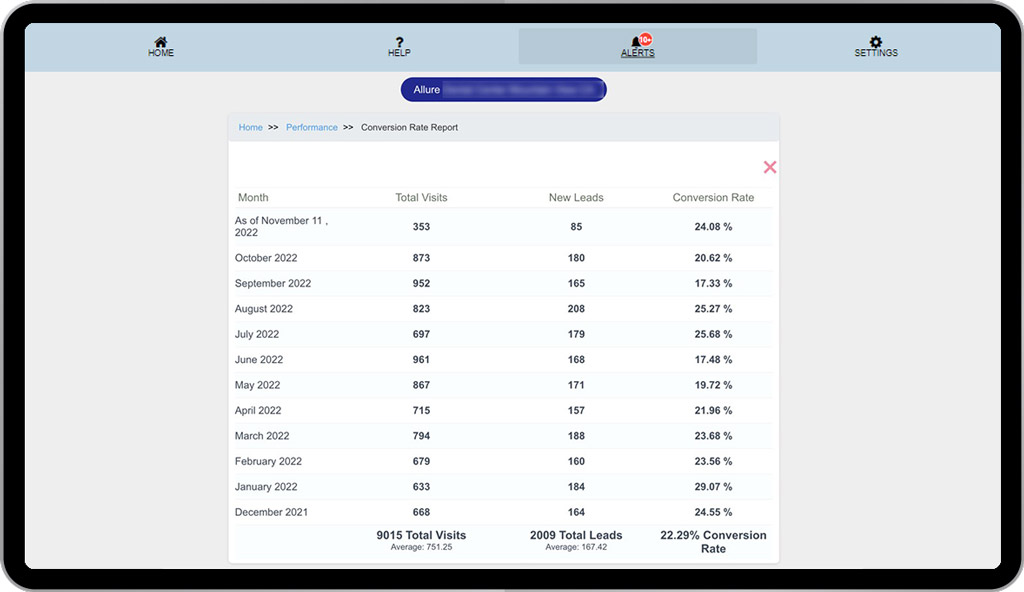
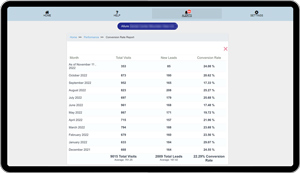
8 Benefits of the paid advertisement (Google PPC) for dentists
When a patient needs to look for a new dental provider, much of their search will be online. They will use a search engine (like Google or Bing) to look for local dental practices and investigate if they can provide the services they are looking for themselves or their family. A search engine generally provides three different types of results in this order from top to bottom: Paid results, map results, and organic results. Usually, at least three paid results are displayed in initial search results, and they are the first thing any potential patient will see. Even if a dental practice appears in map and organic results, it is still necessary and beneficial to appear in paid results. Participating in paid advertising with search engines will give dentists a competitive edge over other practices operating in their area. Below are some benefits of paid advertising for dental practices.
Benefit no 1. Dental practices have more control over where they appear in paid results (PPC Google ads)
A dental practice can influence where their website will appear in organic and map results in search engines, but to say they have control over it is a bit of a stretch. Even when dental practices try to influence these rankings, it can take time, and the results may not be what they want. A dental practice can determine when its ads will appear with paid ad results. Paid ads look almost the same as organic results but are often highlighted on-page as an ad showing users that someone paid for this placement.
Unlike organic results, a dental practice has more control if their site will appears in paid results. If enough budget is allocated to a campaign, it will be more likely to appear as the first paid result instead of the second or third results. Studies show that the first paid result has two to three times more conversions than other paid ads listed at the top. Having more influence on those rankings makes paid results much more agile allowing marketing campaigns to meet their goals.
Benefit no 2. The results from paid advertising are much more immediate compared to organic rank changes
One of the most noticeable benefits of paid advertising is that dental practices will see results immediately. As mentioned before, changes in organic results take time. Even the most fantastic search engine optimization work and content marketing will require a practice to wait to see results. Paid advertising on search engines will show results much faster. As such, paid advertising can perfectly complement organic SEO work on a site if set up correctly.
Once a paid campaign is set up, keywords selected, ad copy has been written, landing paid link provided, and budget allocated to it, a dental practice will see that ads appear quickly. A dental practice can expect to see paid results appear within a day or two once an ad campaign has launched. If ads are not appearing, there is a technical issue with the campaign that needs to be looked at. Depending on how competitive an area is and the keywords selected, there might not be enough budget to support a campaign. The ad budget is either being exhausted too quickly, or the amount of money a dental practice is willing to pay per click is lower than other competitors. Campaigns generally try to find as many clicks as possible as soon as possible. Depending on the budget, this might mean that ads appear in the morning to early afternoon and then begin not to appear in the evenings. It is generally thought to be a good strategy as getting a potential patient to click first thing in the morning might make it more likely for them to make an appointment the same day, compared to a click late at night after business hours.
Benefit no 3. A dental practice can reach the ideal patient with paid advertisements (PPC Google ads)
Online paid advertising is very agile compared to traditional marketing. A dental practice can determine who sees their ads and where they appear. For example, if a dental practice wanted to advertise to people in a specific community looking for a root canal, a campaign can be set up to accomplish the goal. Ads would only appear to people who used a specific keyword in that particular area. Advertising the same ad in a newspaper would be immensely inefficient. The advertisement about root canal services would certainly reach people looking for them. However, it is unlikely to reach them when they were actively looking for that service, and it would also reach many people who had zero interest in those services. What would be the point of advertising it in the newspaper to someone who bought the paper to check sports scores or stock prices?
Paid advertising also gives dental practices control of when their ads will appear. Many dentists will stop showing ads after they close for the day if there is still a budget available. It does not make much sense to advertise a service that is no longer available that day and staff will not be available to answer any questions about it. It is more valuable to have advertising start before the start of business. In the few hours before a dental practice opens, patients can review information, wait to call, or leave a message that will be returned to them within the same day.
Benefit no 4. A dental practice can select its best-performing keywords to display ads (PPC Google ads)
As part of their SEO work on a website, dental practices will know which keywords perform best and which ones will be used by potential patients ready to make an appointment. These keywords will form the backbone of keywords they will select to advertise on. A dental practice does not need to spend any marketing money on keywords that have low conversion rates. For example, a dental practice knows that a “pediatric dentist” search might be people looking for a provider. It will also be used by people looking for more general information but maybe not be ready to make an appointment. By comparison, “pediatric dentist near me” is the keyword used by people actively looking for a dental provider.
Keywords that tend to have higher conversion rates will likely be very competitive and more expensive to bid on. However, ignoring them all together will make it easier and cheaper for competitors to snatch up these words and advertise to potential patients. It will likely be impractical to put enough budget with every keyword to dominate all paid results, but allowing some budget will make a dental practice very competitive with other practices.
Benefit no 5. A dental practice will only pay for the clicks they receive
In traditional marketing, a dental practice will pay for its ad regardless of its performance. A practice only pays when people click on the paid result with online paid advertising. This business model is known as a PPC or pay-per-click. A dental practice literally only pays if their ad does anything. With that said, a poorly performing ad may find it difficult to appear in search results. A search engine is a business also, so they will only want to display ads that will get clicks and are relevant to their user’s search.
Pay-per-click models make it easy for dental practices to manage their advertising budget. Online ad platforms generally give a practice an idea of how much a click will cost on a keyword. (Keep in mind these prices will go up and down over time.) For example, if the budget is $100 a day and their keywords are $2 or $3 per click, they will have an idea of how many clicks they’ll receive per day compared to if other keywords were 75 cents per click. Ads will stop once a budget is used up, so dental practices do not get surprise bills at the end of the month.
Benefit no 6. A dental practice can easily measure its ROI or return on investment (PPC Google ads)
Compared to other online and offline marketing methods, paid search results can be easily tracked for their effectiveness. Every click, ad display, keywords that trigger the ad, and how long that person spent on a website can be tracked. Their journey from start to finish, including whether or not they made an appointment, is recorded and analyzed. This data can then be used to make the overall campaign more effective. Changes can be made in the ad itself or on the website to make it easier to make a conversion. A dental practice will see what ads are working, what ads are not producing the results they were hoping for, and where money is being spent.
Other online marketing methods, such as search engine optimization, are harder to track. Time and money will be spent improving overall organic rankings, but those improvements may not show for months later. By then, the money has already been spent, and it may be difficult to exactly tie a patient back to initial SEO work. It definitely helps a practice, but it is difficult to quantify the exact return on investment. Paid advertising makes it much easier to track.
Benefit no 7. Paid advertising is consistent and a reliable investment of a marketing budget for a dental practice
Other marketing methods, like organic rankings, referral marketing, or even word of mouth, is difficult to gauge in how effective they will be the day to day. Again, they are all essential marketing methods that add to the overall success of a dental practice, but it is hard to plan on when they will produce patients. Paid advertising, when properly managed, can be very consistent. This consistency can then be used as a foundation to try other marketing methods to see what works best for a dental practice.
Once a paid advertising campaign on search engines is launched and time has been given for it to find its footing, a reliable amount of clicks and web traffic will be generated by it. A reliable percentage of those people will make an appointment from those website visits. When a campaign is established, a dental practice can factor into their overall marketing goals the number of patients generated by an online paid advertising campaign.
Benefit no 8. A dental practice can change the budget of its paid advertising campaign at any time (PPC Google ads)
Paid online advertising campaigns benefit from being very agile in terms of their budgeting. The amount of money assigned to an online campaign can be changed whenever a dental practice wants. This allows the practice to react to things quickly and to events they did not plan for initially. For example, if a significant snowstorm causes the practice to close for several days, a dental practice can easily pause its campaign. There is no point in advertising a dental practice if there is 3 feet of snow in the parking lot and no one can get into the office. A dental practice can also boost their budget if they see an opportunity. For example, if another dental practice is closing down or will be closed for an extended period of time, a budget can be increased temporarily to try to lure in those patients for treatment.
Although the budget can be changed quickly by a dental practice, it should be careful not to change it too frequently. Changing a budget daily or every week will make it hard for a campaign to get its footing, and it will be less effective. While practice will still get clicks, it may be more expensive, and they may not be the quality clicks they would get if the budget was steady. The budget for an ad campaign should not be micromanaged. It should be assessed monthly, and adjustments made if needed. Too many adjustments will confuse the ad platform and decrease the overall return on investment of the marketing campaign.
The experts at PatientGain.com are available to help you create a high-performance paid advertising campaign for your dental practice. We have years of experience in creating campaigns on Google and can help create effective paid campaigns on Bing. Contact us today, and let us show you what we have done for other practices across the country!
PatientGain is a dental marketing company that serves all 7 types of dental practices
Dentistry Practices – General dentist
Dentistry – Endodontist – Root Canal Specialist
Dentistry – Oral and Maxillofacial Surgeon
Dentistry – Orthodontist – Alignment Specialist
Dentistry – Pediatric Dentist
Dentistry – Periodontist – Gum Specialist
Dentistry – Prosthodontist – Replacement Specialist
The experts at PatientGain.com are ready to help you with your Dental SEO needs. We can also help you take advantage of new areas of Dental SEO, such as Speech Based Dental SEO. Make an appointment today with our team, and let us show what we can do for you and your business!
